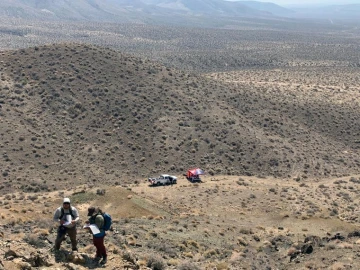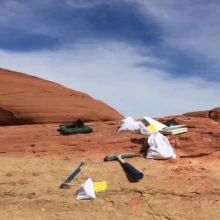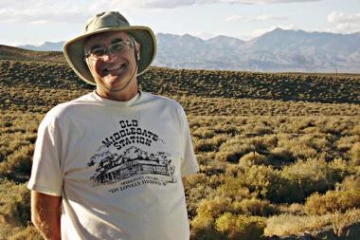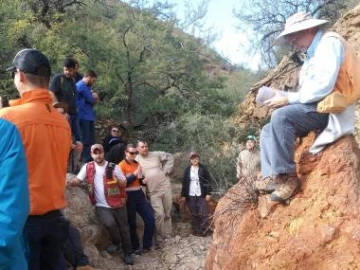May 2022
Two years ago, the wide world we were all used to shrank down to a much smaller size—but at the same time, expanded in ways we could never have imagined thanks to the wonders of online learning. Just like in-person teaching, field trips have returned to the curricula of geoscience, mining, and engineering students.
“Field trips are a critical part of the learning experience as a student in geosciences,” says Eytan Bos Orent, a graduate student in the geosciences department. “It gives students the chance to put classroom knowledge to use by examining the phenomenon discussed in lectures in a hands-on setting.”
Keep reading to learn what some of the participants had to say about the return to education in an outdoor classroom. Spoiler, the Ore Mapping Short Course, a 10-day excursion through Nevada and California was a smashing success.

Arizona is known for having a huge spectrum of geology within a half day drive, so Eytan Bos Orent believes the setting is perfect to get out into the field for students of all levels and interests. Bos Orent, a doctoral candidate in the Department of Geosciences, loves going outdoors, and piecing together geologic stories based on observations made firsthand. “I have been on several field trips during COVID times, each with a different set of goals. All have been fantastic and occurred without hiccup,” Bos Orent says. “I will continue attending them for the foreseeable future.”
Finding it difficult to engage with students through a computer—especially with the many distractions that come with sitting at a computer—Bos Orent says that he benefits a lot from in-person learning and has enjoyed going back to the classroom and participating in field trips. “It’s much easier to interact when you are surrounded by others in the classroom, or when there are beautiful geologic features in front of your face in the field,” Bos Orent says. Overall, his outlook is that field trips are essential for learning. He’s excited to continue attending them for the remaining few years of his degree at UArizona.
On the other hand, Lynnette Hutson, a second-year graduate student pursuing a doctorate in Mining Engineering, is a huge proponent of both in-person and online learning. She believes that a flexible approach is the best way to create a comfortable and efficient learning environment that promotes inclusivity and access for all students. Not all students can benefit from the in-person approach. “I envision more hybrid options in the future. This is similar to the overall conversation many companies are having about the future of work,” Hutson says. “I think instructors will have to consider both modes and adapt their teaching styles accordingly.”
As the pandemic wanes, Hutson maintains that it’s important to have as much in-person instruction as possible. While it’s easier than ever to pivot to remote instruction, it’s hard to replace the face-to-face experience and connections you can build with your peers that may be lost between screens.
Hutson’s opinions extend to fieldwork, as well. Thanks to her geoscience background, she learned that going on trips and seeing the geology for yourself is critical for understanding the real world. The scope of processes that create ore deposits are complex and reading about them just isn’t the same. “One of the strengths of the Ore Mapping Short Course is that it is a unique opportunity to see many different types of ore-forming systems and to place them in the greater context of the tectonics of the Western Cordilleran margin,” Hutson says.
According to her, the best part of the course was that despite the impressive amount of information to take in, it was presented in a way that was interesting for both beginners and veterans in the mining industry. There was plenty to learn for participants of all levels. “I loved it! I would definitely be interested in attending more of these trips. When it comes to field trips, I think they are very doable with a few precautions in the event someone becomes sick,” Hutson says.

If proper protocols (like respecting social distances and wearing masks, for example) are followed, Claudio Araya says that students can adapt to any situation. Araya is a PhD candidate in Geological Sciences who visited from the University of Texas at El Paso. Before pursing his graduate degree, he spent more than a decade working as a mine geologist in the northern Chile’s copper mining industry. “I chose to participate in this field trip mainly because of the prestige of the University of Arizona and its professors,” Araya says. “I think that the level of the courses in general very high, according to my colleagues and personal experiences.”
The recent trip lived up to the hype, apparently, as Araya very much enjoyed the structure and presentation of materials in the course. He was thrilled that the trip included a significant focus on facets of economic geology, and that the other participants were all enthusiastic to answer any questions he could come up with along the way. He’s already looking forward to future expeditions and opportunities to interact with students, professionals, and professors. “In my opinion, it is necessary to return to in-person classes,” Araya says. “The interaction is an important part of our professional and personal development.”
“In short, as the saying goes, ‘The geologist who sees the most rocks, wins!’,” says Alec Martin, a second-year master’s candidate in Economic Geology. Martin, who’s already applied to continue his research on ore forming systems with a PhD program at the UArizona, agrees that it’s hard to replace the experience of in-person field observations. He’s excited for the safe implementation of a return to normal—whatever that may mean.
For Alec, the trip was a great chance to see more geologic systems and to learn about how other geologists operate in the field. There’s no other way to gain that knowledge than to go out yourself and spend time learning from others, though there are always cases where online learning still comes out on top. “For instance, recorded lectures can get the bulk of ‘educating’ done beforehand to allow for better group discussion later,” Araya says. “Personally, there are certain speakers that I relish being able to put on double speed with a pre-recorded video lecture.” It’s a case-by-case basis for Araya of when online versus in-person learning are better.
Field trips are hard to replace and will always have a place in geological and engineering research. There is a reason that this year's Lowell Program in Economic Geology Short Courses are already in their 18th season!

Eric Seedorff
Eric Seedorff and Mark Barton are the highly experienced tour guides and lecturers of this course.

Mark Barton (on the right)

